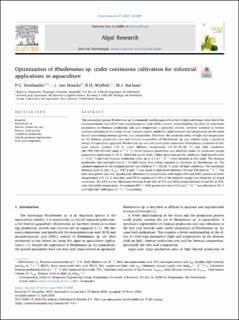| dc.contributor.author | Oostlander, Pieter C. | |
| dc.contributor.author | van Houcke, Jasper | |
| dc.contributor.author | Wijffels, Rene Hubertus | |
| dc.contributor.author | Barbosa, Maria J. | |
| dc.date.accessioned | 2021-03-04T09:24:27Z | |
| dc.date.available | 2021-03-04T09:24:27Z | |
| dc.date.created | 2021-02-18T14:11:03Z | |
| dc.date.issued | 2020 | |
| dc.identifier.citation | Oostlander, P. C., van Houcke, J., Wijffels, R. H. & Barbosa, M. J. (2020). Optimization of Rhodomonas sp. under continuous cultivation for industrial applications in aquaculture. Algal Research, 47: 101889. doi: | en_US |
| dc.identifier.issn | 2211-9264 | |
| dc.identifier.uri | https://hdl.handle.net/11250/2731572 | |
| dc.description.abstract | The microalgae species Rhodomonas sp. is commonly used in aquaculture for its high nutritional value due to the eicosapentaenoic acid (EPA) and docosahexaenoic acid (DHA) content. Understanding the effect of cultivation parameters on biomass production rate and composition is presently limited, however essential in further commercialization of this strain. Under nutrient replete conditions, light intensity and temperature are the main factors determining biomass growth and composition. Therefore, the combined effect of light and temperature on the biomass production rate and biomass composition of Rhodomonas sp. was studied using a statistical Design of Experiment approach. Rhodomonas sp. was cultivated under continuous (turbidostat) conditions in lab-scale reactor systems (1.8 l) under different temperature (15–20–25–30 °C) and light conditions (60–195–330–465–600 μmol m−2 s−1). Stable biomass production was observed under all conditions except experiments performed at 30 °C, which led to cell death. Under optimized growth conditions, high growth rates (>1.0d−1) and high biomass production rates, up to 1.5 g l−1 d−1, were obtained in this study. The biomass production rate reported here is >10-fold higher than values reported in literature on Rhodomonas sp. The optimal temperature for maximal growth was found at T = 22–24 °C under all light conditions. The maximum biomass yield on light (Yx,ph – 0.87 g mol−1) was found at light levels between 110 and 220 μmol m−2 s−1. The fatty acid profile was only significantly influenced by temperature, with higher EPA and DHA contents at lower temperatures (15 °C). A total fatty acid (TFA) content of 8–10% of the total dry-weight was found for all tested conditions. The EPA content fluctuated between 9 and 16% of TFA and DHA content between 6 and 9% of TFA, only affected by temperature. A maximum EPA + DHA production rate of 114 mg l‐−1 d−1 was obtained at 20 °C and high light (600 μmol m−2 s−1) conditions. | en_US |
| dc.language.iso | eng | en_US |
| dc.publisher | Elsevier | en_US |
| dc.rights | Navngivelse 4.0 Internasjonal | * |
| dc.rights.uri | http://creativecommons.org/licenses/by/4.0/deed.no | * |
| dc.title | Optimization of Rhodomonas sp. under continuous cultivation for industrial applications in aquaculture | en_US |
| dc.type | Peer reviewed | en_US |
| dc.type | Journal article | en_US |
| dc.description.version | publishedVersion | en_US |
| dc.rights.holder | © 2020 The Author(s) | en_US |
| dc.subject.nsi | VDP::Matematikk og Naturvitenskap: 400::Zoologiske og botaniske fag: 480::Plantefysiologi: 492 | en_US |
| dc.subject.nsi | VDP::Matematikk og Naturvitenskap: 400::Basale biofag: 470::Molekylærbiologi: 473 | en_US |
| dc.source.pagenumber | 9 | en_US |
| dc.source.volume | 47 | en_US |
| dc.source.journal | Algal Research | en_US |
| dc.identifier.doi | 10.1016/j.algal.2020.101889 | |
| dc.identifier.cristin | 1891399 | |
| dc.description.localcode | Paid Open Access | en_US |
| dc.source.articlenumber | 101889 | en_US |

